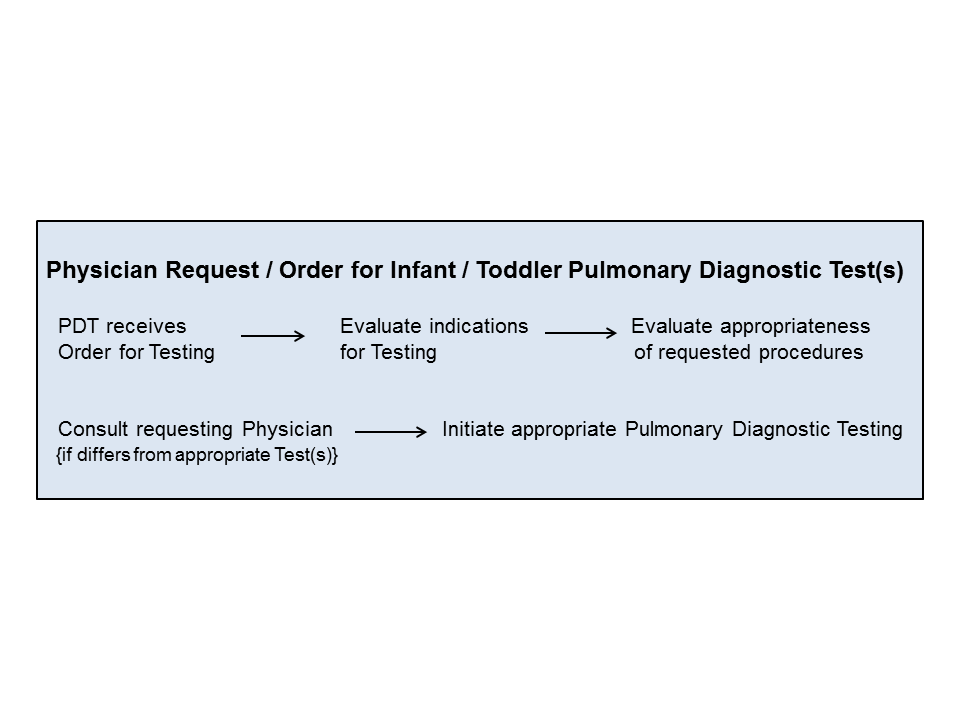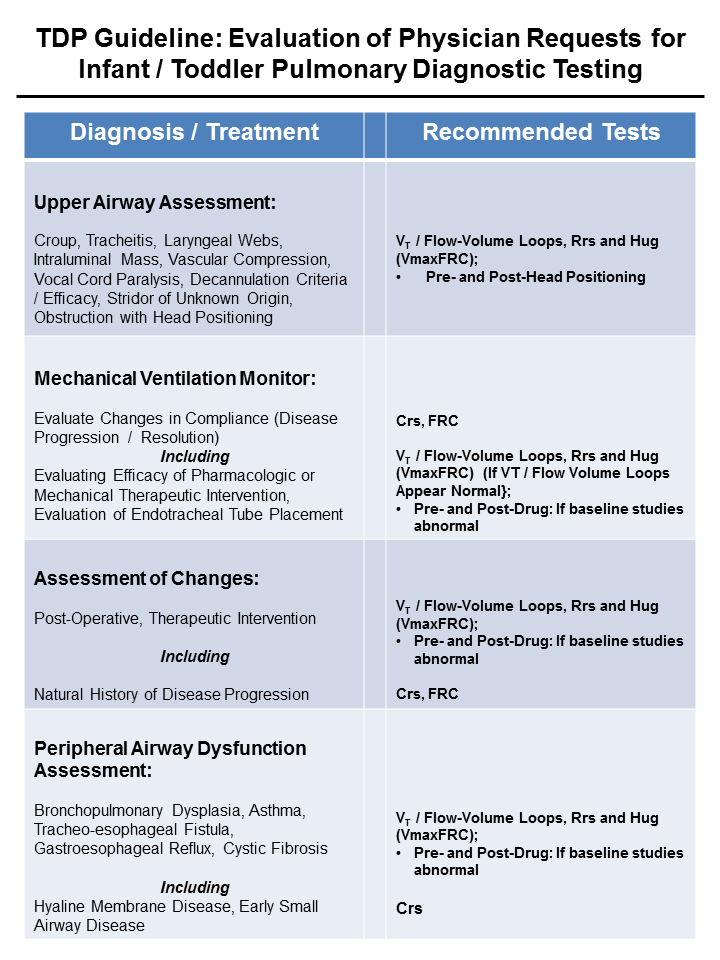Before continuing, I’d like to provide a point of clarification regarding this Technologist Driven Protocol (TDP).
Requests for Infant / Toddler pulmonary diagnostic testing were derived from either Pediatric Pulmonary Services or via Pediatric Pulmonary consultations.
Therefore, unlike the previously described TDPs, this Guideline was primarily employed as a quality improvement feedback system for requested Infant/Toddler pulmonary diagnostic testing. That is, based upon the subject’s diagnosis, or medical history, using this guideline, the Pulmonary Diagnostic Technologist (PDT) verified the appropriateness of the requested procedures. The PDT either contacted the requesting physician, if the requested testing was inconsistent with the guideline (and recommended the appropriate test(s)), or initiated the appropriate testing regimen.
In this manner, the PDT is viewed as a physician consultant and, more importantly, as a physician-extension.
Additionally, unlike the other TDPs, this Guideline did not undergo the rigors of a 12 month evaluation and modification period. This TDP Guideline was designed and implemented using the PDCA cycle (see Implementation Science section for description of term).
==========================================================================================================
I. PROTOCOL: GUIDELINE: EVALUATION OF PHYSICIAN REQUESTS FOR INFANT / TODDLER PULMONARY DIAGNOSTIC TESTING
II. PURPOSE: To maintain continuity and assure appropriateness of physician orders for pulmonary diagnostic testing. The Pulmonary Diagnostic Technologist (PDT) will evaluate each request for Infant / Toddler pulmonary diagnostic testing, with regard to diagnosis or current/past medical history relative to requested procedures. If the requested testing does not conform to this protocol, the PDT will notify the requesting physician and recommend appropriate test(s).
III. PATIENT TYPE: All patients referred, for testing, to the Pediatric Pulmonary Diagnostic Services.
IV. TESTING AREA: Pediatric Pulmonary Diagnostic Laboratory area.
V. EQUIPMENT AND FORMS NEEDED:
1. Calibrated (with verified calibration) infant/toddler pulmonary diagnostic equipment.
2. Physician order (written, electronically generated, verbal), or “Request for Infant/Toddler Pulmonary Diagnostic Testing”
3. Guideline: Evaluation of Physician Requests for Infant / Toddler Pulmonary Diagnostic Testing
4. Testing medication(s)
VI. OVERVIEW: The PDT will assess each request received by the Pulmonary Diagnostic Services.

VII. PROTOCOL: The following guideline will be followed when assessing appropriateness of physician requests for Infant / Toddler Pulmonary Diagnostic testing and are indicated by the PDT TDP Guideline.
1. The following conditions are accepted indications for Pulmonary Diagnostic Testing1:
A. to aid in diagnosis of lung disorders (e.g., reactive airways disease)
B. to follow the natural history of lung growth, or disease presenting in infancy (e.g., cystic fibrosis)
C. to evaluate therapeutic responses (e.g., to medication or physical or respiratory interventions)
D. to allow for prediction of risk of subsequent pulmonary dysfunction based upon initial testing.
2. The selection of the appropriate infant/toddler pulmonary diagnostic test(s) will be based upon the following subject Diagnosis (Medical History) or Treatment; including, but not limited to:
A. Upper Airway Assessment: Croup, Tracheitis, Laryngeal Webs, Intraluminal Mass, Vascular Compression, Vocal Cord Paralysis, Decannulation Criteria / Efficacy, Stridor of Unknown Origin, Obstruction with Head Positioning
B. Mechanical Ventilation Monitor: Evaluate Changes in Compliance (Disease Progression / Resolution), including Evaluating Efficacy of Pharmacologic or Mechanical Therapeutic Intervention, Evaluation of Endotracheal Tube Placement
C. Assessment of Changes: Post-Operative, Therapeutic Intervention, including Natural History of Disease Progression
D. Peripheral Airway Dysfunction Assessment: Bronchopulmonary Dysplasia, Asthma, Tracheo-esophageal Fistula, Gastroesophageal Reflux, Cystic Fibrosis, including Hyaline Membrane Disease, Early Small Airway Disease.
VIII. GUIDELINES / WARNINGS:
1. Although Infant/Toddler Pulmonary Diagnostic Tests are generally safe procedure, the following untoward events may occur:
A. vomiting with aspiration with consequent apnea and laryngospasm and/or bronchospasm
B. pneumothorax
C. increased intracranial pressure
D. transmission of contagion(s)
E. oxygen desaturation
2. Monitor subject’s heart rate (before, during and after) beta-agonist administration. The need to change medication may be indicated by:
A. A heart rate greater than 120 bpm, or if a pulse increase of 20 bpm occurs with bronchodilator medication. Technologist statement must appear on the final report.
B. Patient is receiving noncardioselective beta-blocker therapy.
3. After repeated rapid thoracoabdominal compression efforts, worsening of some pulmonary function parameters (e.g., partial expiratory-flows and airway mechanics) may indicate airway hyperreactivity
4. Technologist test “Quality Statements” must accompany all final reports.
A. Technologist should never report values which do not reflect the patient’s true pulmonary physiology.
1) The Technologist needs to provide clear documentation as to why results were not reported. For example, “Despite repeated attempts, the specified test(s) was/were unable to be performed in an acceptable and reproducible manner. Because of this no data are being reported at this time.”
IX. TECHNOLOGIST RESPONSIBILITY:
1. The Guideline: Evaluation of Physician Requests for Infant / Toddler Pulmonary Diagnostic Testing protocol will be used to evaluate all infant / toddler subjects referred for testing to the Pediatric Pulmonary Diagnostic Services.
2. Immediately notify the requesting physician if subject experiences an untoward event during testing.
3. Inform Pulmonary Diagnostic Services Directors (Pediatric Medical and Technical) about physicians who are repeatedly reluctant to comply with PDT recommendations to alter requested procedures to those that are more appropriate.
A. As a component of the Pulmonary Diagnostic Services Quality Assurance program, these recalcitrant ordering physicians may need to be reeducated in this matter.
X. SUPPORTING REFERENCE
1. American Association for Respiratory Care Clinical Practice Guideline: Infant/Toddler Pulmonary Function Tests. Respir Care 1995;40(7):761-768.
==========================================================================================================

Return to Resources at: https://pftlabresources.com/resources/